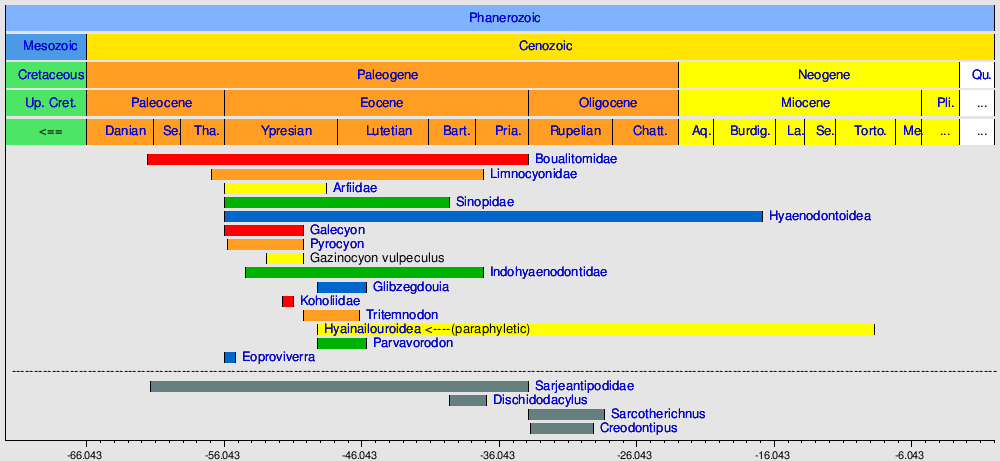Gazinocyon
izumrli rod placentalni sisara
Gazinocyon (Газинокион — „газинов пас”) је изумрли род плаценталних сисара из изумрлог реда Hyaenodonta, који је у периоду раног еоцена настањивао подручје Сјеверне Америке.[6][7][8]
| Gazinocyon Временски распон: рани еоцен
| |
|---|---|

| |
| доња вилица врсте Gazinocyon vulpeculus | |
| Научна класификација | |
| Домен: | Eukaryota |
| Царство: | Animalia |
| Тип: | Chordata |
| Класа: | Mammalia |
| Ред: | †Hyaenodonta |
| Род: | †Gazinocyon Polly, 1996[1] |
| Типска врста | |
| †Gazinocyon vulpeculus Matthew & Granger, 1915
| |
| Врсте | |
| |
| Синоними | |
|
синоними рода:
| |
Етимологија назива
уреди| Род: | Поријекло назива од: | Значење назива: |
|---|---|---|
| Gazinocyon | газинов пас |
| Врста: | Поријекло назива од: | Значење назива: |
|---|---|---|
| G. vulpeculus |
|
мали лисицолики Газинокион |
Систематика
уредиКласификација
уреди| Врста: | Распрострањеност фосила и локација: |
Временски распон: |
|---|---|---|
| †G. vulpeculus (Matthew & Granger, 1915)[9] | САД (Вајоминг)[10] | 53,0 до 50,3 мил. год. |
Филогенија
уредиДоље приказан кладограм представља филогенетске везе рода Gazinocyon.[11][12][13][14][15]
| †Hyaenodonta |
|
†Lahimia група †Arfia група †Galecyon група †афро-арабијска група | |||||||||||||||||||||||||||||||||||||||||||||||||||||||||||||||||||||||||||||||||||||||||||||||||||||||||||||||||||||||||||||||||||||||||||||||||||||||||||||||||||||||||||||||||||||||||||||||||||||||||||||||||||||||||||||||||||||||||||||||||||||||||||||||||||
Временска распрострањеност рода Gazinocyon унутар реда Hyaenodonta
уреди
Види још
уредиРеференце
уреди- ^ P. D. Polly (1996) "The skeleton of Gazinocyon vulpeculus gen. et. comb nov. and the cladistic relationships of Hyaenodontidae (Eutheria, Mammalia)." Архивирано на сајту Wayback Machine (25. јун 2023) Journal of Vertebrate Paleontology 16(2):303-319
- ^ A. V. Lavrov (1999) "Adaptive Radiation of Hyaenodontinae (Creodonta, Hyaenodontidae) of Asia." in 6th Congress of the Theriological Society, Moscow, April 13–16, p. 138 [in Russian].
- ^ Floréal Solé; Bastien Mennecart (2019). „A large hyaenodont from the Lutetian of Switzerland expands the body mass range of the European mammalian predators during the Eocene”. Acta Palaeontologica Polonica. 64 (2): 275—290. doi:10.4202/app.00581.2018 .
- ^ R. S. Rana, K. Kumar, S. P. Zack, F. Solé, K. D. Rose, P. Missiaen, L. Singh, A. Sahni and T. Smith (2015) "Craniodental and postcranial morphology of Indohyaenodon raoi from the early Eocene of India, and its implications for ecology, phylogeny, and biogeography of hyaenodontid mammals." Journal of Vertebrate Paleontology 35(5):e965308:1-22
- ^ Philip D. Gingerich and Harvey A. Deutsch (1989). „Systematics and evolution of early Eocene Hyaenodontidae (Mammalia, Creodonta) in the Clarks Fork Basin, Wyoming” (PDF). Museum of Paleontology, University of Michigan. 27 (13): 327—391.
- ^ McKenna, Malcolm C.; Bell, Susan K. (1997). Classification of Mammals Above the Species Level. New York: Columbia University Press. ISBN 978-0-231-11012-9. Приступљено 16. 3. 2015.
- ^ G. F. Gunnell (1998) "Creodonta". In C. M. Janis, K. M. Scott, and L. L. Jacobs (eds.), "Evolution of Tertiary Mammals of North America, Volume 1: Terrestrial Carnivores, Ungulates, and Ungulate like Mammals", Cambridge University Press, 703 pages ISBN 9780521355193
- ^ Floréal Solé (2013). „New proviverrine genus from the Early Eocene of Europe and the first phylogeny of Late Palaeocene–Middle Eocene hyaenodontidans (Mammalia)”. Journal of Systematic Palaeontology. 11 (4): 375—398. doi:10.1080/14772019.2012.686927.
- ^ W. D. Matthew and W. Granger (1915) "A revision of the Lower Eocene Wasatch and Wind River faunas." Bulletin of the American Museum of Natural History 34(1):1-103
- ^ D. A. Guthrie (1971.) "The Mammalian Fauna of the Lost Cabin Member, Wind River Formation (lower Eocene) of Wyoming." Annals of Carnegie Museum 43(4):47-113
- ^ Borths, Matthew R.; Stevens, Nancy J. (2017). „Deciduous dentition and dental eruption of Hyainailouroidea (Hyaenodonta, "Creodonta," Placentalia, Mammalia)”. Palaeontologia Electronica. 20 (3): 55A. doi:10.26879/776 .
- ^ Matthew R. Borths; Nancy J. Stevens (2019). „Simbakubwa kutokaafrika, gen. et sp. nov. (Hyainailourinae, Hyaenodonta, 'Creodonta,' Mammalia), a gigantic carnivore from the earliest Miocene of Kenya”. Journal of Vertebrate Paleontology. 39 (1): e1570222. doi:10.1080/02724634.2019.1570222.
- ^ Floréal Solé; Bernard Marandat; Fabrice Lihoreau (2020). „The hyaenodonts (Mammalia) from the French locality of Aumelas (Hérault), with possible new representatives from the late Ypresian”. Geodiversitas. 42 (13): 185—214. doi:10.5252/geodiversitas2020v42a13.
- ^ Solé, F.; Morlo, M.; Schaal, T.; Lehmann, T. (2021). „New hyaenodonts (Mammalia) from the late Ypresian locality of Prémontré (France) support a radiation of the hyaenodonts in Europe already at the end of the early Eocene”. Geobios. 66-67: 119—141. doi:10.1016/j.geobios.2021.02.004.
- ^ Averianov, Alexander; Obraztsova, Ekaterina; Danilov, Igor; Jin, Jian-Hua (2023). „A new hypercarnivorous hyaenodont from the Eocene of South China”. Frontiers in Ecology and Evolution. 11. ISSN 2296-701X. doi:10.3389/fevo.2023.1076819/full.